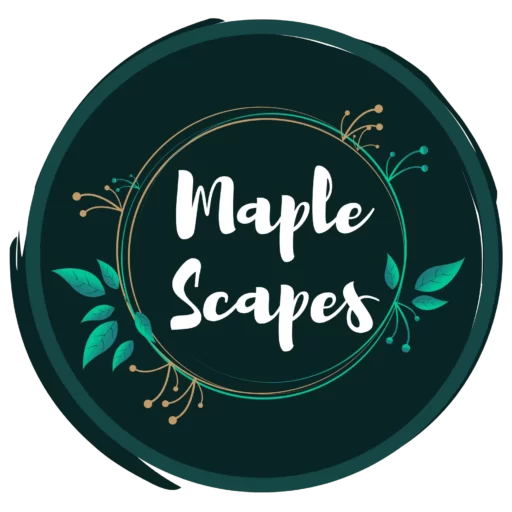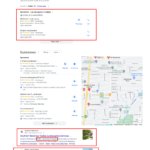We will introduce you to the cutting-edge measuring wheels that are transforming the landscape estimation process.
These tools are not just about measuring distances; they’re about enhancing efficiency, boosting accuracy, and elevating your landscaping projects to new heights.
So, let’s roll forward and explore these game-changing tools that are set to redefine your landscaping estimation process. Your next project deserves nothing less than the best!
Best innovative measuring wheels
Carta by Plott
Carta is undoubtedly the leader in measuring innovation. Because of its advanced features that let you map properties digitally, you can do a lot of calculations quickly without having to pick up a piece of paper and a pen.
The digital measuring wheel is water-resistant and lets you attach a phone to the handle to see real-time measurements.
The bearings of the wheel are smooth. The handle could be better for comfort.
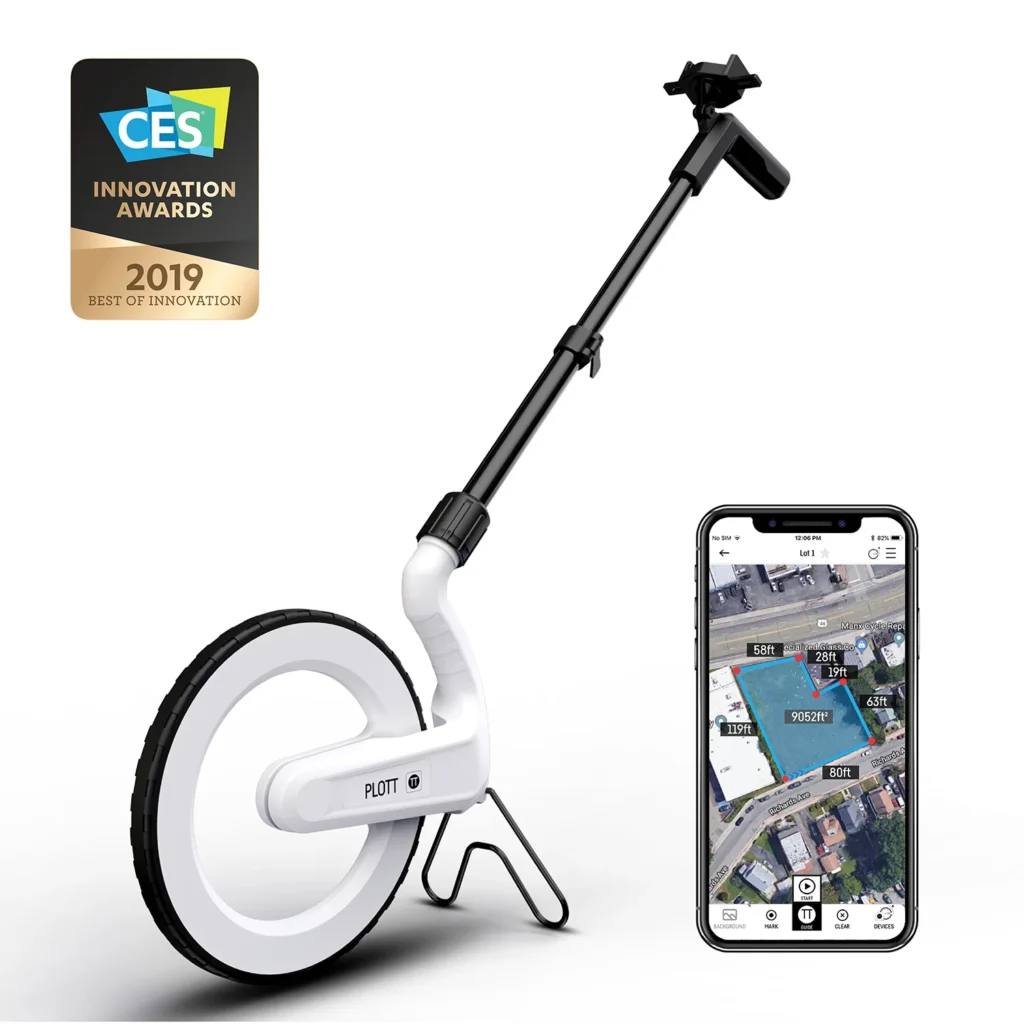
Pros:
- Completely digital measurements along with digital mapping of the property
- Works for 18 hours in a single recharge.
- You can estimate right within the app (use it if you do not use landscape estimation software)
- In-app guidance. You can use the guidance to reach the starting point or take a turn.
Cons:
- The instructions manual missing a lot of tutorials (they have how-to videos on the website)
- App use can sometimes be frustrating and buggy.
- You need a phone with a Carta account to save everything (not suitable for the tool changing hands frequently)
- The tool is so lightweight but can sometimes be frustrating to use on very rough surfaces with rock.
Carta Price: $325
Moasure
Moasure is an absolute cutting-edge innovation in the face of measuring systems that we use today. Rather than a traditional wheel – it relies on sensors to map the terrain and lets you measure pretty much anything.
A little expensive for our taste and to be honest a lot of features are of no use for mid-level residential projects.
Moasure also gets a sweet mention in our best property mapping apps, so it’s not just useful for calculating distances but has many more features that a simple measuring wheel just cannot do.
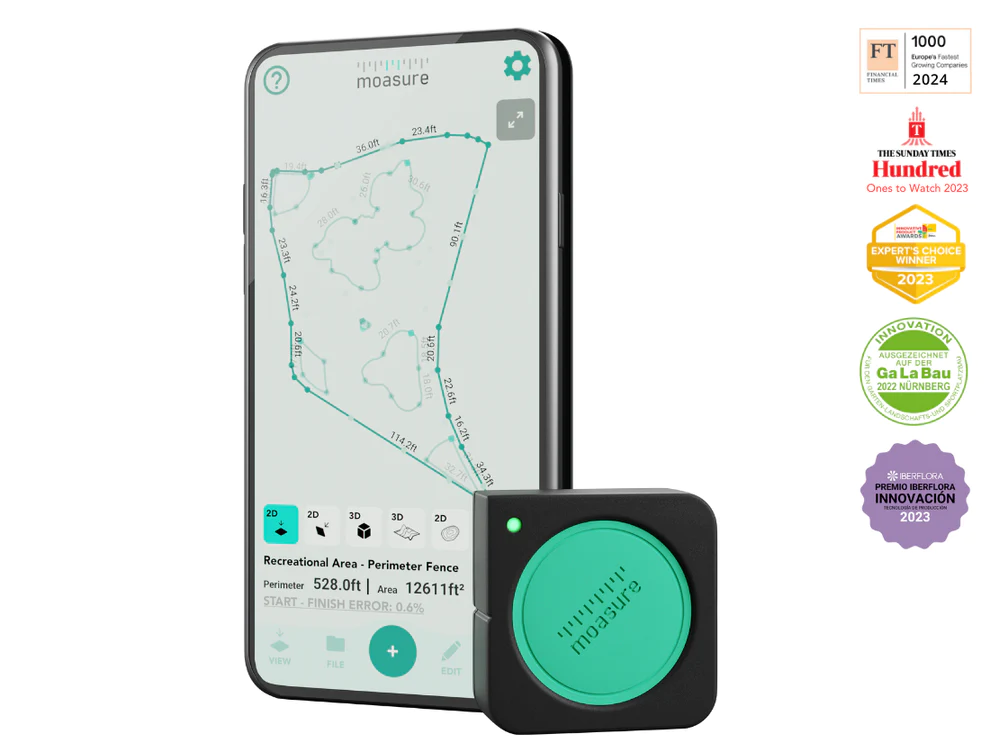
Pros:
- Measures where a wheel can’t. No surface is difficult since it is you just waving it in the air around that surface.
- Lets you factor in elements from within the app.
- You can export your measurements to CAD for blueprinting.
- Now measures 3D terrain
Cons:
- Takes a while to get used to. Accuracy depends on how you wave it around the site.
- You hit the device on a rock and you risk losing $500.
- It is not always super accurate. Might not match the surveyor’s measurements on a large site.
- It has be to kept straight. You tilt too much and the measurements going to be off.
Moasure price: $779
DigiRoller Plus III
Digiroller is the next best thing if you are not too sold on newer digital measuring devices such as Carta or Moasure.
Digiroller Plus III features a nifty instrument cluster with very useful rubber buttons that help you pause, store, and see real-time measurements.
The ball bearings are smooth and the instrument is backlit so you can work at night. Comes with a wrist lanyard so it doesn’t slip right out of your hands on rough terrain.
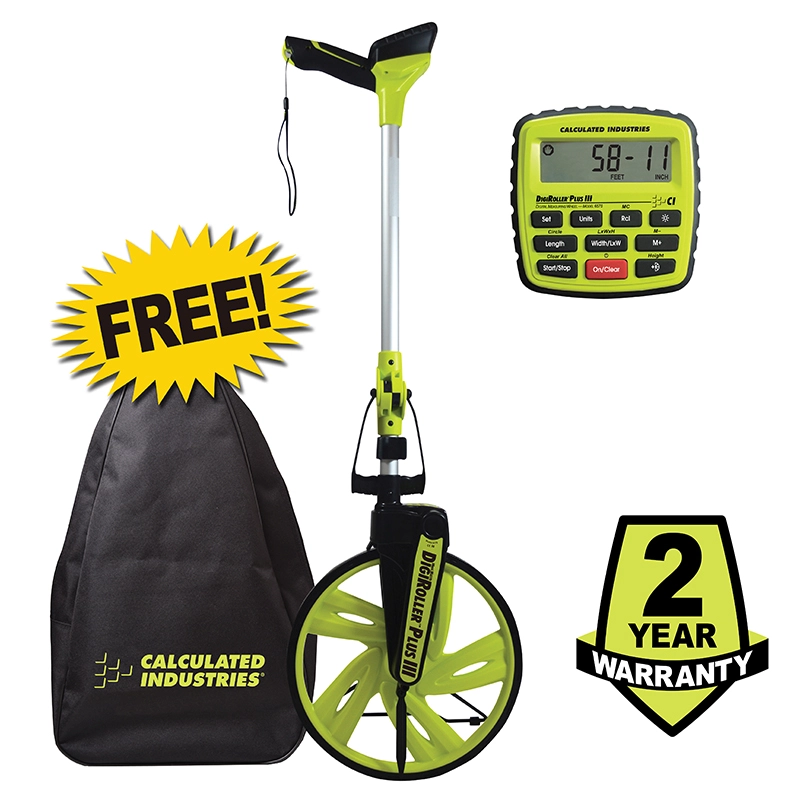
Pros:
- Measure in Imperial – US or metrics (with metric mode)
- You can operate with your thumb so you do not have to bend down and your back wouldn’t hurt.
- Calculate the area with just a button and it has a memory.
Cons:
- You have to save measurements or it will get lost if you keep it turned on while on a break from measuring.
- The clear button is easy to press so you might have to keep your fingers and thumbs out of the way so as not to reset your measurements.
- Sometimes slips on wet grass after 1 year of use because the rubber at the end of the wheel has smoothened out.
Comes with a 2-year warranty and a backpack case.
Digiroller plus 3 Price: $160
Milwaukee 12” Measuring wheel
Handle-mounted controls are sturdy, and the name Milwaukee says it all. This is a durable measuring wheel where the innovation is just not in the electronics but in the overall design.
The makers have given thought to the minute details so you do not worry about the weather or terrain while using it.
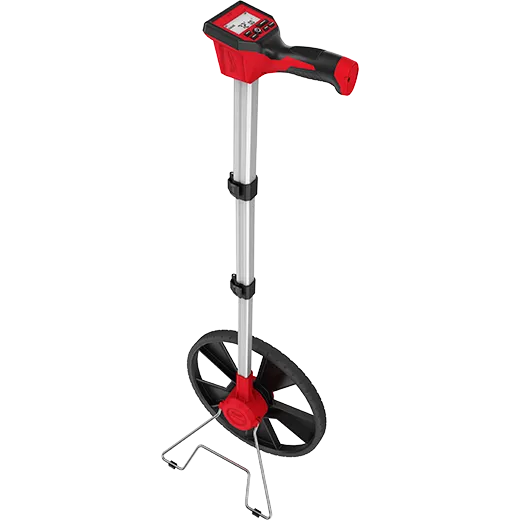
Pros:
- It has a mechanical brake to stop your measurements
- It has a little mud flap so the first doesn’t add up to your wheel and increase the circumference.
- Comes with three measurement modes (metric, imperial, and engineer)
Cons:
- The digital module is not water resistant. So you cannot wash off your wheel. It would just fit the display.
- The thumb reset for the counter gets stuck down and has to be manually pulled back up
Milwaukee 12′ Price: $100
Bosch GWM 32 Measuring wheel
If you are looking for a non-digital measuring wheel but still want an innovative product – Bosch GWM 32 should be your choice.
It uses an analog counter mounted at the wheel and has a piston grip. The GWM 32 is very simple to use yet very effective for all surface types. The rubber tread used in this is very durable and wouldn’t slip up. The ball bearings are of good quality (It’s Bosch after all) and the grip is sturdy.

Pros:
- Lightweight. Has a die-cast aluminum wheel.
- Completely analog so you don’t have to worry about batteries or water.
Cons:
- The telescopic shaft is good but starts collapsing after heavy usage.
- The protective bag feels cheap and doesn’t look durable.
Bosch GWM 31 Price: $100
UCS Professional Measuring wheel
UCS professional measuring wheel takes it up a notch when it comes to digital measuring wheels. It uses a magnet sensor (rather than a light beam and sensor) to calculate distance. This ensures that dust or other particles do not fault your measurements.
The rugged casing protects the counter and the handle grip is designed to exert less strain on your wrist.
Simple. Fast. Effective.
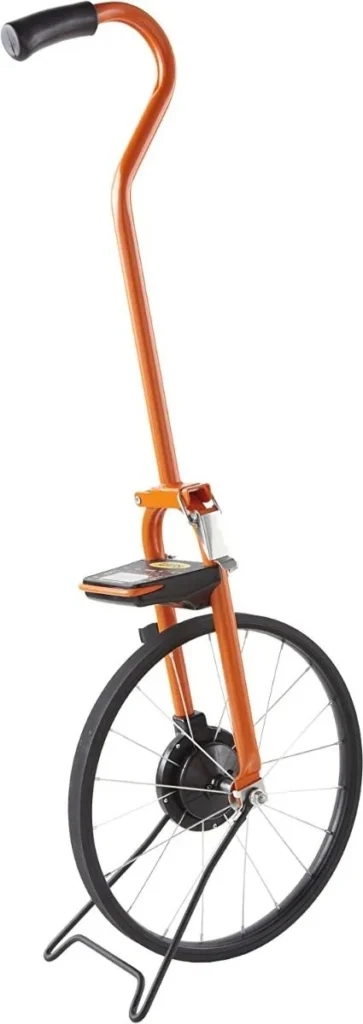
Pros:
- Has magnetic sensors that are better than the lasers.
- Very simple design with an intuitive instrument panel
Cons:
- The instrument sits above the wheel but below the handle which can require you to bend in sunlight.
- The stand after a while loses its motion so you’d have to remove it or it will stop the wheels while you are walking.
UCS Pro Price: $239
How to select the best measuring wheel for landscaping jobs
Our landscaping experts have used hundreds of measuring wheels combined. These are some of the things you should look for a durable and accurate measuring wheels.
The bearings should be smooth
The wheel’s bearings should operate smoothly and without resistance. This ensures that the wheel turns easily and measures accurately, even over rough terrain. High-quality bearings also reduce wear and tear, extending the life of the measuring wheel.
If the bearing is not smooth, your measurements will suffer. It is because if the wheel is at any point stuck, it would slip over smooth surfaces or after rain.
The handle should feel just the right weight
The handle’s weight is important for comfort and control. A handle that’s too heavy can cause fatigue, while one that’s too light may feel flimsy or unstable. Look for a handle that has a good balance of weight and strength.
“Heavy but not too heavy so it hurts your palms. Not so light that the wheel jumps out of your hands”
Digital display for storing measurements
Some measuring wheels come with digital displays that can store and recall measurements. This can be very useful for complex landscaping jobs where multiple measurements are needed. Look for a model with a clear, easy-to-read display and intuitive controls.
“Store measurements digitally rather than running down to the truck, yelling down to somebody onsite with noise”
Backlit if you’re working at night
If you often work in low-light conditions, consider a measuring wheel with a backlit display. This makes it easier to read measurements in the dark. Some models also have reflective or glow-in-the-dark markings for added visibility.
A backlit display doesn’t only work in low light, it also helps to look at the digits on a sunny day.
The instrument is at the top so your back doesn’t hurt at the end of the day.
Ergonomics is key when choosing a measuring wheel. The instrument should be positioned at the top of the handle, so you don’t have to bend over to read it. This can help prevent back strain and improve comfort during long measuring sessions.
Durability – telescoping handles generally aren’t durable. After some time they just start collapsing.
While telescoping handles can be convenient for storage and transport, they may not be as durable as fixed handles. Over time, the locking mechanism can wear out, causing the handle to collapse unexpectedly. If durability is a priority, consider a measuring wheel with a solid, one-piece handle.
FAQs
How much bigger of a wheel do I need?
You need a 12-inch measuring wheel for most of your landscaping projects.
Smaller wheels (4 inches to 6 inches in diameter) – Realtors, claims adjusters, accident investigations, indoor contractors and designers, architects, carpet layers, and roofers.
Medium wheels (6 inches to 12 inches in diameter) – Contractors, golf course maintenance and other landscapers, cement and paving contractors, plumbing and irrigation workers.
Larger wheels (15 inches or more in diameter) – Farmers, ranchers, landscapers, land management professionals, athletic supply stores, schools.
Do rocks and bumps alter distance significantly?
While theoretically uneven surface and you moving the wheel around would impact your measurement, the difference would actually be insignificant unless you measuring miles of property.
The accuracy is not a problem with measuring wheels. But how you use the wheels, job site conditions, and your usage define accuracy.
How do I get square footage from a distance?
Square foot = length (feet) x breadth (feet)
This formula assumes that the area you’re measuring is a rectangle or square. If the area has an irregular shape, you might need to divide it into smaller rectangles or squares, calculate the square footage of each, and then add them together to get the total square footage.
Do I need a dual-wheel system for landscaping jobs?
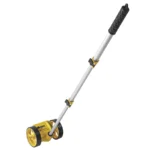
Dual-wheel measuring wheels can be more expensive and may be bulkier than single-wheel models. If you’re working in tight spaces or need to carry the tool for long periods, a lighter, single-wheel model might be more suitable.
